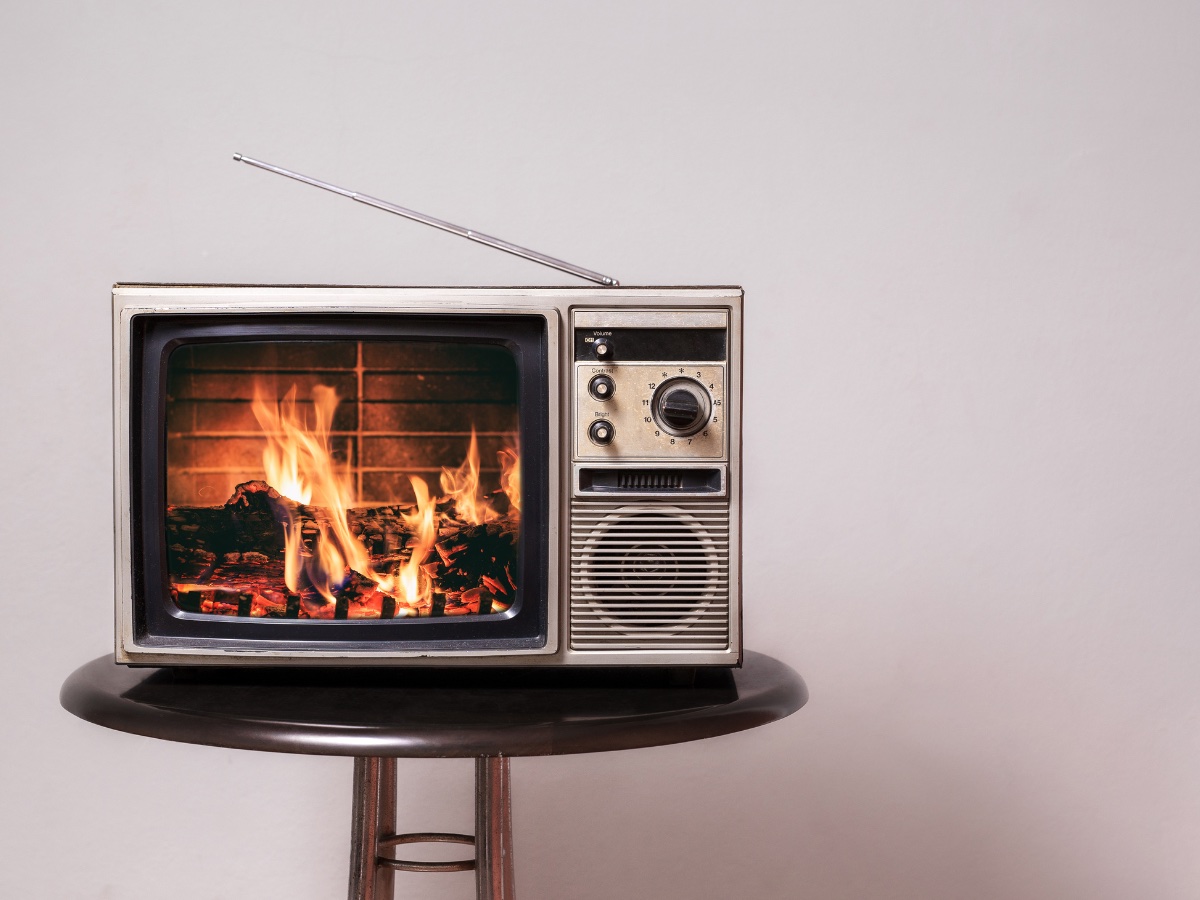
Videos of roaring fireplaces have gone viral in the past decade, but the peculiar phenomenon of fake fire television dates back far longer.
Half a dozen logs are burning in a brick fireplace, with a satisfying clack and crackle punctuating the fiery background hum. Occasionally a spark flies up from one of the logs, a plume of smoke momentarily emerges amid the flames. Nothing else happens. For ten hours.
It doesn’t sound like a recipe for a viral hit, but this seemingly run-of-the-mill video has racked up almost fifty-eight million hits on YouTube. And it’s not alone: from crackling cabin fireplaces surveyed by pedigree cats, to birchwood fires backdropped by piano music and jazz, there’s an entire cottage industry devoted to the virtual fireplace.
The original spark
The phenomenon is usually backdated to ‘Yule Log’, an American television show that originally aired from 1966 to 1989 on New York station WPIX. The show, between two and four hours in length, featured (as per the title) a film loop of a yule log burning in a fireplace, with a soundtrack of Christmas tunes adding to the holiday ambience.
Inspired by a Coca-Cola commercial showing Santa Claus by a fireplace, the show’s creator, Fred M. Thrower, conceived it as a festive gift to New Yorkers whose apartments usually lacked fireplaces. It was filmed at Gracie Mansions, the official residence of the New York Mayor.
Rarely are Christmas gifts so well-received: such was the programme’s popularity it was broadcast for twenty-three consecutive years without commercial breaks. It was this lost revenue that finally prompted the station’s new general manager to cancel it in 1990.
This flame-free hiatus lasted until the aftermath of the September 11 attacks on the World Trade Center, when it was relaunched by the station’s new president, who recognised that New Yorkers needed ‘comfort food tv’. ‘Yule Log’ was the most-watched TV programme in the New York metropolitan area on Christmas Day 2001 – and has continued to be broadcast ever since.
The seduction of slow television
‘Yule Log’ is often invoked as a precursor of the slow television movement – a term denoting marathon television coverage of everyday events. An even earlier example, in the art world, was Warhol’s 1964 film Sleep, depicting poet John Giorno sleeping for five hours and twenty minutes.
Slow TV is often grouped together with the Slow Movement: a cultural phenomenon that focuses on decelerating the pace of life, most famously with the Slow Food Movement. ‘Slow TV seems slow in part because, unlike our standard experience of the world, it’s unshaped by interior consciousness. Instead of drowning out its viewers’ inner lives, it seems to want to be a backdrop that can give rise to their own reflections,’ wrote Nathan Heller in the New Yorker.
Both fireplace TV and the wider Slow TV movement were to experience a major renaissance in the late 2000s, courtesy of the Norwegian Broadcasting Corporation (NRK), whose initial offering in 2009 followed a seven-hour train journey.
Four years later, NRK broadcast the twelve-hour-long Nasjonal vedkveld (National Wood Night) on the topic of firewood, with nearly a million people (twenty percent of Norway’s population) tuning in. The programme was inspired by Norwegian author Lars Mytting’s best-selling book Solid Wood: All About Chopping, Drying and Stacking Wood — and the Soul of Wood-Burning. It involved people talking about and chopping wood followed by eight hours of a live fireplace, and spawned articles in The New York Times and beyond.
Unlike ‘Yule Log’, which ran on a loop, the programme actually took place in real time, with minimal editing – an essential qualification for true Slow TV, with viewers chiming in online to suggest how best to place the logs to keep the fire burning.
One viewer, niesa36, told the Dagbladet newspaper website: ‘I couldn’t go to bed because I was so excited. When will they add new logs? Just before I managed to tear myself away, they must have opened the flue a little, because just then the flames shot a little higher. I’m not being ironic. For some reason, this broadcast was very calming and very exciting at the same time.’
A hypnotic effect
Perhaps it’s no surprise that Norway, a country where 1.2 million households (50% of all homes) have fireplaces or wood stoves, would succumb to fireplace TV. But the love of flames and a comforting hearth is far from a uniquely Scandinavian thing – seeming to respond to an in-built need in humans across the world, whether or not they have access to a real fireplace.
The importance of fire in human evolution is a field that has generated a huge amount of research, from the effects of cooking to the way that fire created a new kind of social space enhancing human cooperation and bonding.
But can virtual fires have the same effect? Intriguingly, that was very much the finding of University of Alabama anthropologist Christopher Dana Lynn. In a 2014 study, Lynn compared the blood pressure of 226 adult subjects before and after they viewed simulated fire on a DVD; some viewed muted fire, others fire with sound, and others still a blank screen.
‘Results indicated consistent blood pressure decreases in the fire-with-sound condition, particularly with a longer duration of stimulus, and enhancing effects of absorption and prosociality,’ he wrote.
There is, then, a scientific reason why millions of people mystically set their screens to flickering fires: they’re performing a kind of self-care that’s both more affordable and more accessible than a real fireplace, and also simulating a fireside space to promote reflection and sociability.
Meanwhile, plenty of content providers continue to fan the virtual fireplace flames, with streaming giant Netflix’s ‘Fireplace for your Home’ films spawning multiple episodes. Creator George Ford had the idea after viewing ‘Yule Log’, and thought it was time for an update. He told The Independent he estimates that his most popular films may have racked up seventy million views – though the streaming service doesn’t release figures.
Netflix’s birchwood fireplace special is viewed by fans as a particularly mythic episode – birchwood creating bigger flames but producing less actual heat. But then again, that’s not a problem in the context of a virtual flame.
Such is the programme’s popularity that, when Netflix removed it from their site in January 2021, it was met with widespread panic. But it seems unlikely that Netflix will resist such good TV for long, and in the interim the series has a dedicated website offering for sale over a dozen DVDs of its ‘wholesome and family oriented programming’.
Perhaps inevitably, given the worldwide success of virtual flames, advertising companies have also got in on the act. Notably Budweiser, whose inexplicable but engaging video of a Dalmatian and a Clydesdale horse in front of a flickering fire features a strategically placed crate of Bud.
Given that the original ‘Yule Log’ was anti-advertising at its core, the fake flame phenomenon appears to have come full circle – but, on the positive side, virtual fires are meant to be like background music. There’s no need to concentrate on what’s being sold. Just let the ad play while you work on relaxation and reducing your blood pressure.


